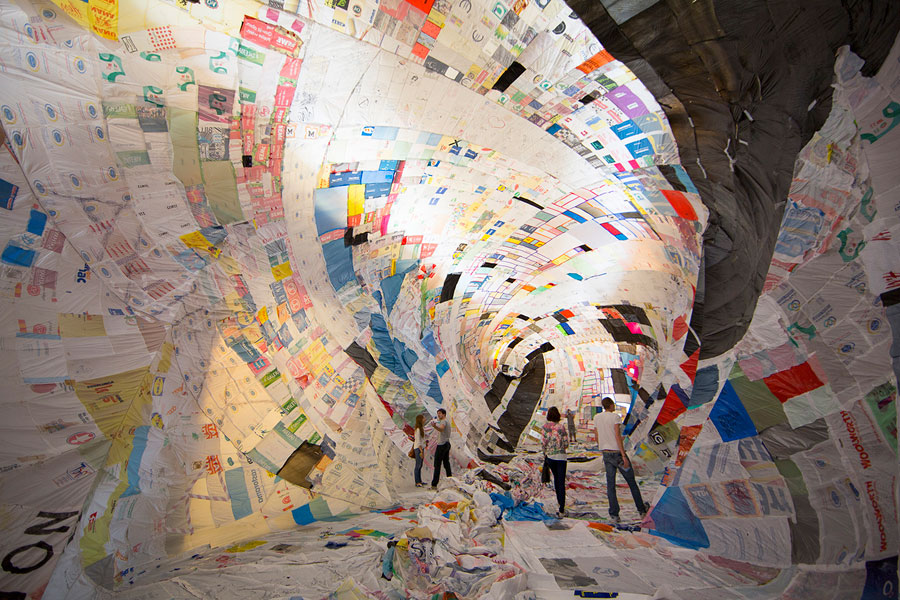Tomás Saraceno’s Aerocene is astonishing for many reasons. Foremost is the degree to which his experiment manifests the salient principle of thermodynamics as the motor of its operation: the universe abhors a gradient.[1] What is so cunning and breath-taking about this project, though, is how it deploys this principle. It projects the work of habitation and mobility aloft in the most abundant but lowest quality gradients on the planet: the dynamics of aero-solar exergy gradients in the atmosphere.[2]
The urbanization of this extremely low-quality but massively abundant gradient is a spectacular and mesmerizing basis for form; one that will likely take years to fully comprehend and realize. It is a stunning and ingenious model of formation, one whose thermodynamic depth is perhaps barely perceptible to most observers.[3] But this is exactly the munificent invitation of Aerocene: to peer into the sublimity of its formation and thusly envision an entirely different thermodynamic model for living in this century.[4]
To name but just one pertinent dimension of this model of formation, in a stunning inversion Saraceno grasps the prevailing problem of radiative forcing that today, we are told, otherwise threatens qualities of life on this planet.[5] He immediately and generously inverts that “problem” into the very gradient that will support many aspects of life in his aero-polis. The almost-nothing of our atmosphere that threatens everything today becomes, in his model, the everything that affords nothing other than a profoundly relevant political and thermodynamic model for life in this century.
In this way Saraceno’s model makes us think and think differently another basic principle of thermodynamics: the completely underestimated importance of system boundary selection.[6] All the key contemporary planetary dynamics—so often construed as “problems” of scarcity—such as climate change or climbing populations are in fact opportunities of abundance. The difference in this world-view is nothing other than a difference in system boundary characterization. Whereas scarcity-mongers live in constant fear of the isolated system boundaries they unwittingly select and accept to enact the terms of their perceived doomy scarcity, the reality is that humans utilize less than ten percent of incident available solar exergy for its operations.[7]
Saraceno takes the latter open system boundary characterization and its superabundance as his point of departure. Within this context of superabundance, Saraceno envisions a very powerful model of living based on cunning exergy matching of maximal work from his selected, deliriously low-quality gradient. As a formation of matter, energy, and movement, Aerocene should thus challenge many prevailing models for reasoning and imagining our world and how we might live with it today.[8]
In both emblematic and literal terms—and in formal, political and scientific terms—the dynamics of his formations are entirely reliant on a non-isolated conception of the world as a system.[9] Further, more immediately at a human scale, his formations of people, plastic, air and the sun serve as a constant reminder—an index—of the operative system boundaries of Aerocene. This amends the depravity of our pervasive, seemingly invisible metabolic rifts that are a primary enabling fiction of contemporary neoliberal life. To become Aerosolar, and to enter the age of Aerocene is to, finally, become astutely aware of one’s system boundaries as the basis of a novel polis. It is a consummate model of cosmopolitanism.
If the Romans came closest to a fully thermodynamic model of telluric civilization, Saraceno has begun to devise an analogical Aerosolar model. A deeply important dimension of the project is in the convergence of its physical and political realities as inextricably coupled systems. We too readily forget today that every political model is constitutively thermodynamic and that every thermodynamic model is deeply political.[10] In the case of Aerocene it is thoroughly provoking to imagine political systems based entirely on insolation-based intensive properties of the atmosphere such as temperature, pressure, and density; as manifests in varied jet streams, storms, or doldrums. Not since John Wellesley Powell vainly envisioned the political organization of the American West as a watershed model of the polis has such a convergent physical and political model of life emerged in modernity.
These thermodynamic, formal, and political models astutely merge in Saraceno’s project. In this way Saraceno offers us an ambitious model of contemporary formation, one far beyond timid and disabling models of isolating autonomy that stupidly constrict artistic, architectural, and urban praxis.[11] Instead, Aerocene affords us a glimpse into a model—a different model of causality—for that which could afford and accommodate life today.[12] It is the only truly immanent, thermodynamic model of design in the domain of architecture and urbanization, driven as it is by the intensive properties of its formation. It eclipses—by orders of magnitude and significance—the bafflingly obdurate hylomorphic approaches to art, architecture, design, and urbanization that otherwise clog our current models.
The above is at most suggestive of the magnificence of Aerocene model and its thermodynamic depth. More than any other model for living and formation today, Saraceno challenges our current modes of imagination and reasoning and, in a gush of goodwill and optimism, offers a beguiling and ponderous alternative model for how we might best live today.












